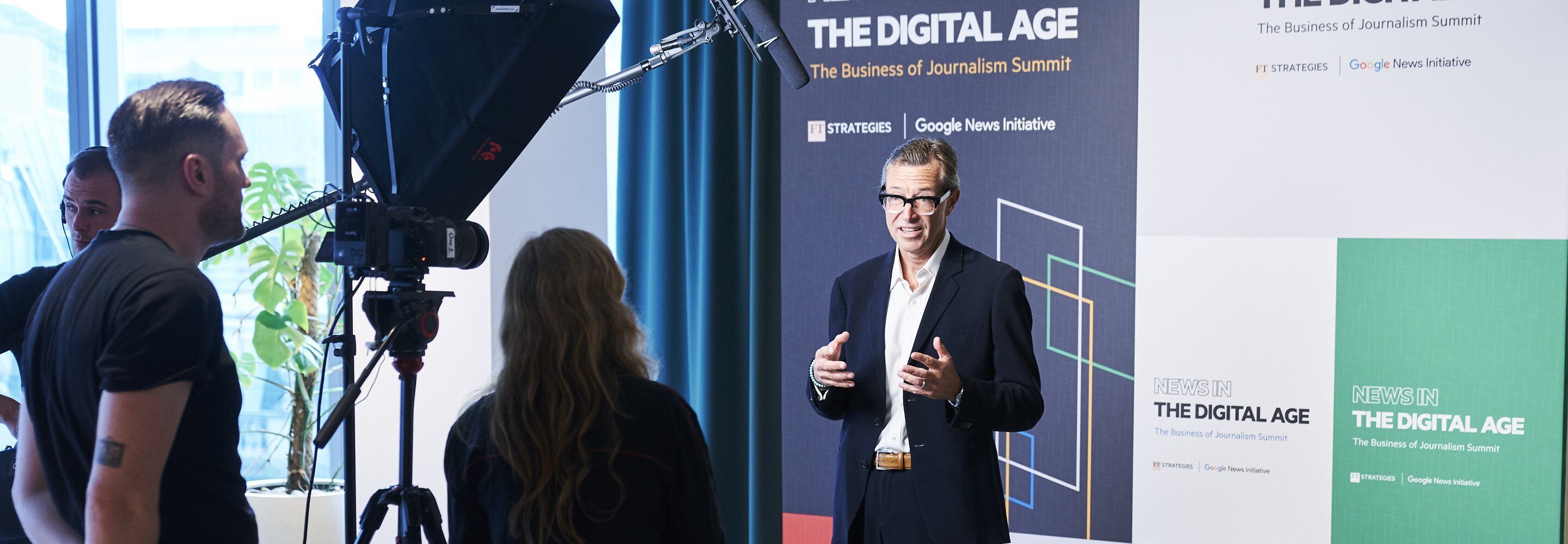
Kicking off our second News in the Digital Age event, John Ridding, CEO of the Financial Times Group, gave an exclusive live interview on how the Financial Times navigated its own digital transformation to reach one million paying subscribers a year ahead of schedule.
Interviewing him was Lea Korsgaard, Founder and Editor-in-Chief of Denmark’s Zetland. She asked Ridding about the challenges he faced when setting their original North Star goal, and what was next for the FT.
Ridding recalled how the institution has persevered during ‘bumpy’ times towards its new North Star: achieving a Global Paying Audience of 3 million.

John Ridding, CEO of the Financial Times Group and Lea Korsgaard, Founder and Editor-in-Chief of Zetland at News in the Digital Age 2024
He said the key has been simply having the right business model in place, and that this set the FT Group up to tackle the challenges faced by news publishers in the digital age such as evolving consumer behaviours or competition with social media.
The FT is in a strong position now, this year surpassing £500m in revenue for the first time, but hasn’t always been out so far in front. Many of the bumps in the road that happened during Ridding’s tenure happened early on, not least the fact that the FT itself was suffering declines in revenue. As Ridding observed “it’s not a good look if you’re the FT writing about money to be losing money yourselves.”
So came the decision to start charging for FT content, a decision that caused as much consternation within the organisation as it would amongst readers. Stakeholders were not only disappointed but felt angry; Ridding himself bore the brunt of discontent from unhappy staffers. However, this did not affect Ridding’s clarity in his decision-making. The objective was to achieve a direct relationship with all of the FT’s institutional customers by emphasising the value of quality journalism.
“If you don’t get the business model right, you’re not going to be able to deal with any of the other challenges.”
As Ridding surmised, this led to “two years of pain” in which a ‘significant’ amount of high-margin revenue was sacrificed. However, the long-term opportunity at stake was seen as worth striving for, so the FT pushed through.
A crucial part of messaging was Ridding’s reinforcement of the axiom that premium content is paid for because it has inherent value. In speaking to FT journalists, Ridding affirmed that the choice to increase the price of the newspaper reflected the organisation’s central belief that the journalism is “worth a lot more” than the £1 price it had been for five years prior.

John Ridding, CEO of the Financial Times Group and Lea Korsgaard, Founder and Editor-in-Chief of Zetland at News in the Digital Age 2024
Korsgaard asked Ridding about Nikkei’s role as owners of the FT Group since 2015. Ridding remarked that this has been a happy relationship because “they themselves understand news. Because they are of the industry, they get it.”
Crucially, Ridding made clear that the ethics and values of the FT’s audience were understood by Nikkei and that this understanding allowed both organisations to succeed. As Ridding mentioned when asked about the companies’ working relationship, “the key is always going to be about understanding the interests of our readers, not a mogul.”
“As an organisation, we must retain a sense of purpose and remember what our mission is: providing reliable, trustworthy journalism. If any part of the ownership structure fails to see that, then we will all fail.”
This is manifested in the FT’s ability to move fast, something enabled by having clear organisational alignment and establishing a ‘circle of trust’ composed of people who understand how to deal with challenges through lived experience.
Ridding said that “as an organisation, we must retain a sense of purpose and remember what our mission is: providing reliable, trustworthy journalism. If any part of the ownership structure fails to see that, then we will all fail.”
Korsgaard asked Ridding to explain where he sees the opportunities to embrace AI within the FT newsroom. Ridding mentioned that the FT is approaching AI experimentation “thoughtfully and carefully” while trying to understand and embrace the technology while it evolves.
The news media industry, Ridding said, is “still in the foothills of what is clearly going to be possibly the biggest ever series of tectonic disruption driven by AI” and faces a series of prevalent risks, not least disintermediation.
Ultimately, however, Ridding remained optimistic and focused on the opportunities that exist for today’s news media companies rather than the pitfalls. He said “the doom loop is probably overstated” and an opportunity has emerged for news media to optimise their business models through better use of AI. Applying predictive analytics to address consumer acquisition, user retention, and churn make up the “hard science that’s part of a successful dynamic subscription model” as we have at the Financial Times.
At FT Strategies, we work with news and media organisations globally, helping them address strategic challenges, drive sustainable growth and innovate using AI, technology and data. If you would like to chat about any of these topics with our expert consultants, please get in touch.

.jpg?width=768&name=gettyimages-118386322_copy.jpg__1440x500_q90_crop_subsampling-2_upscale%20(1).jpg)


